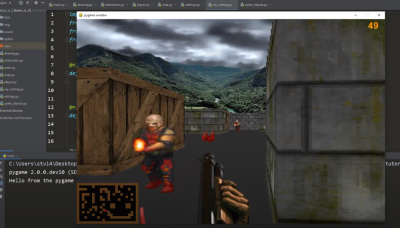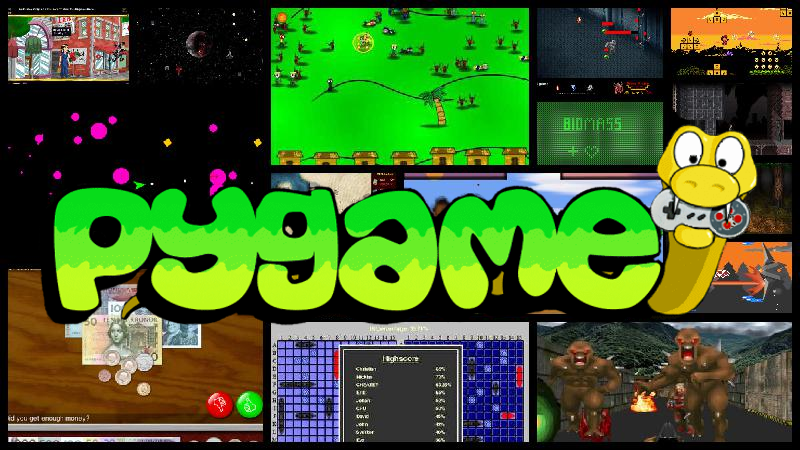Python is an absolutely fantastic language for tossing bits of data around and gluing different software components together. But eventually you may find yourself looking to make a program with an output a bit more advanced than the print() statement. Once you’ve crossed into the land of graphical Python programming, you’ll quickly find that the PyGame library is often recommended as a great way to start pushing pixels even if you’re not strictly making a game.
Today, the project is celebrating an incredible milestone: 20 years of helping Python developers turn their ideas into reality. Started by [Pete Shinners] in 2000 as a way to interface with Simple DirectMedia Layer (SDL), the project was quickly picked up by the community and morphed into a portable 2D/3D graphics library that lets developers deploy their code on everything from Android phones to desktop computers.
Things haven’t always gone smoothly for the open source library, and for awhile development had stalled out. But the current team has been making great progress, and decided today’s anniversary was the perfect time to officially roll out PyGame 2.0. With more than 3,300 changes committed since the team started working on their 2.0 branch in July of 2018, it’s a bit tough to summarize what’s new. Suffice to say, the library is more capable than ever and is ready to tackle everything from simple 2D art up to 4K GPU-accelerated applications.

If you haven’t given PyGame a try in awhile, don’t worry. The team has put special effort into making the library as backwards compatible as possible, so if you’ve got an old project kicking around that you haven’t touched in a decade, it should still run against the latest and greatest version. If you’ve never used it before, the team says they’ll soon be releasing new tutorials that show you how to get the most out of this new release.
Whether you’re putting together your own implementation of Conway’s “Game of Life” or creating the graphical front-end for your own Linux distribution, PyGame is a powerful tool to have in your collection. Our sincere congratulations to all PyGame developers, past and present, for making it to this auspicious occasion. We can’t wait to see what the next decade will bring.
[Thanks to deshipu for the tip.]
















Used PyGame once to illustrate how one can observe the outside of our visible Universe (with the help of an Intergalactic Outpost Relay).
How to look over the edge of our visible Universe – Outpost simulation (Blue dot is the Earth, red dot is the outpost, and the circles are the observable range for each – see the video description for details and code)
https://www.youtube.com/watch?v=BjbNZ7SLzwM (shameless plug)
Glad to hear pygame is getting a 2.0!
:o)
I like that you felt able to write a simulation, and I’m happy python and pygame helped.
I assume you know your hypothesis is flawed, the visible universe is limited by the distance light has travelled, not by optics. The only way it’d work is if you could magic your relay away from us faster than light, and communicate back to us faster than light.
The relay is seeing inside its own circle, same as we see inside our circle.
As long as we can see the relay, then we should also be able to receive images broadcasted by the relay (images it can still observes inside its circle, from those areas that are still in its circle but not in our circle any more).
The relay doesn’t have to go faster than light. For example, we can put tomorrow a relay on the moon, and that relay will see slightly deeper in the Moon->Earth direction than we can see from the Earth. The moon relay can record the images and broadcast them later to Earth. No physics laws broken.
Same as with smoke signals, but in outer space.
:o)
I’m confused. A few clarifications:
Observable universe is defined by a sphere such that information has had sufficient time to travel (at the speed of light) from its origin to earth?
Communication of information from outpost to earth is also limited by the speed of light?
The universe is expanding faster than the speed of light (necessary in order for the outpost to leave the observable universe of the earth, which is expanding at the speed of light)?
Time required for information to travel from the outpost to earth must be taken into account. If there is no delay between receiving information at the outpost to retransmitting to earth, then the observable universe is the same for information that must travel from its origin to the outpost and then from the outpost to earth.
Put another way, by the time information flies from the outpost to earth, the earth’s observable universe will have grown to include the origin of the information.
Um. No.
Shannon had it right.
The edge of the observable universe is the distance beyond which there hasn’t been enough time yet for light to reach us thus we cannot see beyond it. If the universe were standing still the observable universe would be a sphere ever-expanding away from us at the speed of light. Thus you need something traveling faster than light in order to catch that sphere.
Sure, at a fixed instant in time your relay on the moon has a sphere that is a relatively infinitesimal distance offset from ours on earth but by the time you can get a signal from there to here our own sphere has expanded to include anything that you relay could have seen.
I mentioned “if the universe were standing still”
So the diameter of our observable universe is constantly growing. Does that mean if we wait long enough we will see objects that are currently beyond the edge? No. Space itself is expanding even faster therefore distant objects are ever-farther away. The more distant they are the more space between us to expand so the more expansion. We see that as everything racing away from us and the farther away it is the faster it is going. Over time we will see less. Eventually only things that are gravitationaly bound to our own local group of galaxies will be visible.
The problem is, while we talk, we are seeing less and less stars. This is because the space expand faster than the speed of light (at the visible edges).
The stars from the very edge of what we can still see today, from Earth, won’t be possible to be seen tomorrow. This is because space expands at a range that makes us see less and less stars every day (I don’t recall the estimation, I think it’s about 30 000 stars less with each day – the small white dots in the animation are stars, and the video shows how stars are constantly leaving the observable circles), and this is where an outpost might come handy.
We can send a probe today, and in a million years from now, the probe would be able to broadcast stars that are still in its range, but the same stars have long gone over the edge of our direct observable range. It will take some time for the pics to travel from the probe to Earth, but we will be able to still see a little further than we would see directly from Earth.
The outpost won’t make _all_ the Universe visible, will only extend the range just a little, would let us see pics with the stars that are now traveling faster than light (apparently, because of the space expansion).
@RoGeorge No, a relay is still not going to help you see stars in the future after the space between us has expanded enough to take them out of our observable universe.
Think of it this way. Light leaves the star and travels towards Earth (and the relay) at the speed of light. Some of it is intercepted by the relay. For simplicity I’ll say the relay instantaneously process the light and encodes it into radio waves. No real life electronics could do that but considering the delay doesn’t really help the conversation. Anyway, so now we have radio waves (really just long wavelength light) leaving the probe towards Earth at the speed of light and we still have original light from the star that wasn’t captured by the relay also continuing on towards earth. Both travel at the speed of light so again, simplifying things, ignoring complications such as the difference in effect on the speed of light that passing through dust and things has at different wavelengths. So both reach earth at the same time.
So, no matter where your probe is it cannot help us see any farther. The fact that at one time before space had expanded as much we could see the star, or if the probe was there at that time isn’t really an issue.
Unless the probe is sending back recordings of what it saw a billion years previous. But that’s nothing real time, just a recording of what we could have seen had we been alive on Earth at the time.